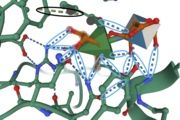Sandbox Reserved 1692
From Proteopedia
(Difference between revisions)
| Line 19: | Line 19: | ||
Quaternary Structure: This protein does not have quaternary structure. | Quaternary Structure: This protein does not have quaternary structure. | ||
| - | Provided <scene name='89/892735/Spacefill/1'>here</scene> is the protein structure in space fill. This structure representation shows how much space certain molecules take up, indicating the depths of the active site and showing how deeply bound the ligand is to the enzyme. This representation also shows what size molecule fit into the active site, giving scientists an idea of other similar-sized ligands that may also fit into this binding pocket. Tan represents the enzyme, green represents the ligands, and | + | Provided <scene name='89/892735/Spacefill/1'>here</scene> is the protein structure in space fill. This structure representation shows how much space certain molecules take up, indicating the depths of the active site and showing how deeply bound the ligand is to the enzyme. This representation also shows what size molecule fit into the active site, giving scientists an idea of other similar-sized ligands that may also fit into this binding pocket. Tan represents the enzyme, green represents the ligands, and blue represents the solvent. |
== Other important features == | == Other important features == | ||
An <scene name='89/892735/Acetate_ion_interactions/1'>acetate ion</scene> is bound to the substrate complex, forming hydrogen bonds with amino acid residues Arg166 and Tyr202. The acetate ion provides more opportunity for the substrate to form interactions with amino acids near, or within, the active site, and may contribute to the elimination of the glycosidic linkages. | An <scene name='89/892735/Acetate_ion_interactions/1'>acetate ion</scene> is bound to the substrate complex, forming hydrogen bonds with amino acid residues Arg166 and Tyr202. The acetate ion provides more opportunity for the substrate to form interactions with amino acids near, or within, the active site, and may contribute to the elimination of the glycosidic linkages. | ||
Revision as of 23:00, 8 December 2021
| This Sandbox is Reserved from 10/01/2021 through 01/01//2022 for use in Biochemistry taught by Bonnie Hall at Grand View University, Des Moines, USA. This reservation includes Sandbox Reserved 1690 through Sandbox Reserved 1699. |
To get started:
More help: Help:Editing |
Structure and Function of FoRham1
| |||||||||||
References
- ↑ 1.0 1.1 1.2 1.3 Kondo T, Kichijo M, Maruta A, Nakaya M, Takenaka S, Arakawa T, Fushinobu S, Sakamoto T. Structural and functional analysis of gum arabic l-rhamnose-alpha-1,4-d-glucuronate lyase establishes a novel polysaccharide lyase family. J Biol Chem. 2021 Jul 22:101001. doi: 10.1016/j.jbc.2021.101001. PMID:34303708 doi:http://dx.doi.org/10.1016/j.jbc.2021.101001

